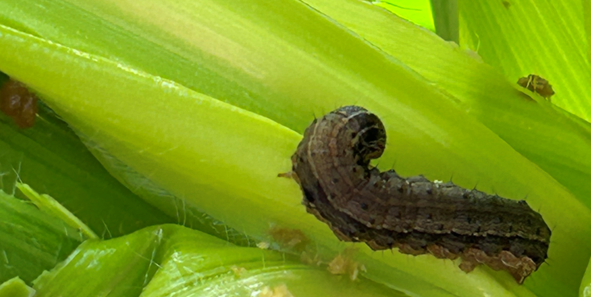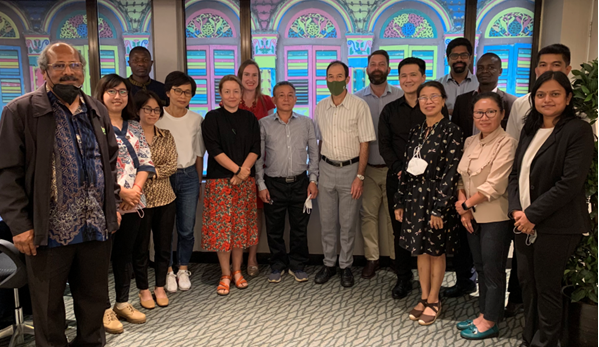Key points
- Fall armyworm moth (FAW) is an invasive agricultural pest across Africa, Southeast Asia, New Zealand, the Pacific, and Australia.
- Our genomic work challenges the previous consensus that FAW only spread eastwards from its native range in the Americas to Africa and then Asia.
- Understanding how FAW arrived in Australia helps us to target management actions and monitor for emerging insecticide resistance.
The fall armyworm moth (Spodoptera frugiperda) is a notorious pest in agriculture. It devastates essential food crops and threatens global food security. It has been reported to feed on more than 350 plant species, ranging from maize to cotton and vegetables.
This pest congregates in mass gatherings or ‘armies’ that can destroy entire crops overnight.
Fall armyworm moth (FAW) is native to tropical and subtropical regions of the Americas. It was first reported in West Africa in 2016, and was assumed to have spread rapidly across Africa, Asia, Southeast Asia, Australia, the Pacific and New Zealand.
In Africa, up to an estimated 17.7 million tonnes of maize is lost annually from FAW. The Food and Agriculture Organization of the United Nations has launched a campaign—the Global Action for Fall Armyworm Control—to coordinate a response. This is where we come in.
Sherlock genomes
CSIRO researcher Dr Wee Tek Tay and his Pest Genomics Team are on the case. The team uses next generation sequencing techniques to analyse the genetic diversity of highly invasive insects. This technique helps us understand insect pests and how they evolve.
The team has been working to identify FAW invasion pathways (where they come from), detect hybridisation (when two different species combine to form a new one), and to see whether FAW is developing resistances to insecticides and biopesticides.
"We used genetic markers to look at gene flow between populations over time and across continents," Tek said.
"We collaborated on a large-scale population genetic analysis of FAW with scientists across Africa, Southeast Asia, East Asia, the Pacific and the European Union to build on a previous project.
"Looking at the whole genome, beyond just mitochondrial genes or narrow DNA markers, revealed just how complex FAW populations are. It gave us a better understanding of how to stop those populations spreading."
Flutter chaos
Dr Rahul Rane, senior research consultant in the Pest Genomics Team and lead author of the study, said they found key genetic signatures that showed FAW had spread westwards from Asia to Africa (populations in Uganda and Malawi). This finding was a surprise.
“Our research findings challenge the previous consensus that FAW simply spread from its native range in the Americas to Western Africa, then the rest of Africa and eastwards across to Asia,” Rahul said.
The research also showed populations in Myanmar and China were distinct. Rather than being genetically linked, as experts had assumed, separate distinct populations of the pest have actually been introduced into Asia multiple times. This was likely due to international trade.
Identifying where human activity has led to introducing FAW to new locations helps us to know where to target better biosecurity practices. Access to this knowledge helps government and industry to protect against further FAW invasions.
Cracking caterpillar ancestry
The research project uncovered some surprises with Australian FAW too. They found Australian FAW populations also had significant genetic differences. This suggests the moths came from separate places and different populations, rather than just spreading from a single introduction point.
The Queensland, Northern Territory and Western Australian populations were significantly different genetically. This indicates there was limited connectivity between these populations during the early stage of the populations being established.
Tek said FAW first spread to Australia in January 2020 from Southeast Asia and Papua New Guinea (PNG), though the Torres Strait and into North Queensland.
"Queensland populations from Walkamin, near Cairns, and further south at Mackay, are genetically closely related to the PNG population. The PNG population shows links back to Yunnan in China," Tek said.
"However, the Western Australian population was more closely related genetically to their neighbours in Malaysia and India.
"This suggests it may have arrived through a different entry in north-western Australia. This matches with the different pesticide resistance profiles detected in the Western Australian and Queensland populations."

Monitoring moth movement
The more we know about FAW movement, the better we can manage this notorious agricultural pest. In particular, its genes show how populations are related. This suggests which trade pathways may need a greater biosecurity focus to prevent any new human-assisted introductions. This is especially important for stopping other exotic Spodoptera species that threaten agricultural crops.
FAW populations differ in their insecticide resistance and feeding traits. This means, in Australia, we need to continue to monitor gene flow into local populations to manage any increased insecticide resistance. Knowing the genetic code will help to develop targeted management strategies for Australia’s agricultural sector.
CSIRO also hosts the Secretariat of the ASEAN Action Plan on Fall Armyworm, providing technical support to efforts in Southeast Asia to combat FAW.
This project was co-funded by us, Australian Centre for International Agricultural Research, Grains Research and Development Corporation, Cotton Research and Development Corporation, FMC Australasia and Corteva Agriscience, and involved research partners from Australia, Africa (Uganda), Southeast Asia (Cambodia, Laos, Vietnam, Myanmar, Malaysia, Indonesia, Philippines, Singapore), East Asia (South Korea), the Pacific (PNG), and the EU (France).

